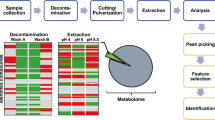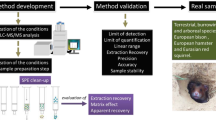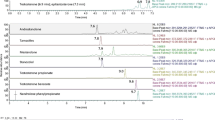Abstract
It is important to profile steroids in many physiological and pathological processes. Recently, hair has been used for the long-term measurement of endogenous steroid hormones. Analyzing hair has advantages of being noninvasive and time sequential compared with other bio-specimens. Liquid chromatography-mass spectrometry (LC-MS) techniques have been widely used over the past decades; however, it is challenging to profile estrogens in hair by LC-MS, and more comprehensive steroid profiling is required. In this paper, an ultra high-performance liquid chromatography-tandem mass spectrometry (UHPLC-MS/MS) method was developed to simultaneously profile 28 multifunctional steroids, including corticosteroids (n = 6), estrogens (n = 13), androgens (n = 5) and progestogens (n = 4), in human scalp hair in a single run. To optimize the sample preparation procedure, we evaluated extraction time, post-incubation purification and hair fragment length; 30 mg hair samples were washed with hexane, cut into 5 mm pieces and incubated in methanol for 18 h at 25 °C. Methanol extraction derivatized using Girard P and dansyl chloride reagent was analyzed within 25 min using an automated injection program combined with a diverter valve switch and step analysis (AIDSA). The method was well validated in terms of linearity, limit of detection (LOD), limit of quantification (LOQ), precision, accuracy, matrix effect and recovery, and was successfully applied to a steroid profile from male and female hairs. Significant differences were observed between genders. In addition, steroids showed a declining trend from the proximal to more distal hair segments; thus, care should be taken when obtaining hair samples for analysis to account for this difference in steroid levels along the length of hair.

The workflow of the estabished UHPLC-MS/MS method






Similar content being viewed by others
References
Eser D, et al. Neuroactive steroids and affective disorders. Pharmacol Biochem Behav. 2006;84(4):656–66.
van Wingen GA, et al. Progesterone selectively increases amygdala reactivity in women. Mol Psychiatry. 2008;13(3):325–33.
Chrousos GP, Kino T. Glucocorticoid action networks and complex psychiatric and/or somatic disorders. Stress. 2007;10(2):213–9.
Gao W, et al. Quantitative analysis of steroid hormones in human hair using a column-switching LC-APCI-MS/MS assay. J Chromatogr B Analyt Technol Biomed Life Sci. 2013;928:1–8.
Noppe G, et al. LC-MS/MS-based method for long-term steroid profiling in human scalp hair. Clin Endocrinol. 2015;83(2):162–6.
Iglesias S, et al. Hair cortisol: a new tool for evaluating stress in programs of stress management. Life Sci. 2015;141:188–92.
Staufenbiel SM, et al. Hair cortisol, stress exposure, and mental health in humans: a systematic review. Psychoneuroendocrinology. 2013;38(8):1220–35.
Chen Z, et al. Simultaneous determination of hair cortisol, cortisone and DHEAS with liquid chromatography-electrospray ionization-tandem mass spectrometry in negative mode. J Chromatogr B Analyt Technol Biomed Life Sci. 2013;929:187–94.
Dettenborn L, et al. The assessment of cortisol in human hair: associations with sociodemographic variables and potential confounders. Stress. 2012;15(6):578–88.
Dettenborn L, et al. Introducing a novel method to assess cumulative steroid concentrations: increased hair cortisol concentrations over 6 months in medicated patients with depression. Stress. 2012;15(3):348–53.
Streit F, et al. Perceived stress and hair cortisol: differences in bipolar disorder and schizophrenia. Psychoneuroendocrinology. 2016;69:26–34.
Steudte-Schmiedgen S, et al. Hair cortisol concentrations and cortisol stress reactivity predict PTSD symptom increase after trauma exposure during military deployment. Psychoneuroendocrinology. 2015;59:123–33.
Manenschijn L, et al. Long-term cortisol in bipolar disorder: associations with age of onset and psychiatric co-morbidity. Psychoneuroendocrinology. 2012;37(12):1960–8.
Manenschijn L, et al. A novel tool in the diagnosis and follow-up of (cyclic) Cushing’s syndrome: measurement of long-term cortisol in scalp hair. J Clin Endocrinol Metab. 2012;97(10):E1836–43.
Noppe G, et al. Elevated hair cortisol concentrations in children with adrenal insufficiency on hydrocortisone replacement therapy. Clin Endocrinol. 2014;81(6):820–5.
Gruber CJ, et al. Production and actions of estrogens. N Engl J Med. 2002;346(5):340–52.
Arnett-Mansfield RL, et al. Relative expression of progesterone receptors A and B in endometrioid cancers of the endometrium. Cancer Res. 2001;61(11):4576–82.
Chakraborti A, Gulati K, Ray A. Estrogen actions on brain and behavior: recent insights and future challenges. Rev Neurosci. 2007;18(5):395–416.
Bechlioulis A, et al. Cardiovascular effects of endogenous estrogen and hormone therapy. Curr Vasc Pharmacol. 2010;8(2):249–58.
Kirschbaum C, Tietze A, Skoluda N, Dettenborn L. Hair as a retrospective calendar of cortisol production-increased cortisol incorporation into hair in the third trimester of pregnancy. Psychoneuroendocrinology. 2009;34(1):32–7.
Gao W, et al. HPLC-FLU detection of cortisol distribution in human hair. Clin Biochem. 2010;43(7–8):677–82.
Choi MH, Kim KR, Chung BC. Determination of estrone and 17 beta-estradiol in human hair by gas chromatography-mass spectrometry. Analyst. 2000;125(4):711–4.
Jung HJ, et al. Gas chromatography/mass spectrometry based hair steroid profiling may reveal pathogenesis in hair follicles of the scalp. Rapid Commun Mass Spectrom. 2011;25(9):1184–92.
Choi MH, Chung BC. GC-MS determination of steroids related to androgen biosynthesis in human hair with pentafluorophenyl-dimethylsilyl-trimethylsilyl derivatisation. Analyst. 1999;124(9):1297–300.
Bevalot F, et al. Analysis of corticosteroids in hair by liquid chromatography-electrospray ionization mass spectrometry. J Chromatogr B Biomed Sci Appl. 2000;740(2):227–36.
Pellegrini M, et al. Role of the sex hormone estrogen in the prevention of lipid disorder. Curr Med Chem. 2014;21(24):2734–42.
Townsend EA, Miller VM, Prakash YS. Sex differences and sex steroids in lung health and disease. Endocr Rev. 2012;33(1):1–47.
Walf AA, et al. I. Levels of 5alpha-reduced progesterone metabolite in the midbrain account for variability in reproductive behavior of middle-aged female rats. Brain Res. 2011;1379:137–48.
Shivers K-Y, et al. Estrogen alters baseline and inflammatory-induced cytokine levels independent from hypothalamic–pituitary–adrenal axis activity. Cytokine. 2015;72(2):121–9.
Zhao Y, et al. Liquid chromatography tandem mass spectrometry determination of free and conjugated estrogens in breast cancer patients before and after exemestane treatment. Anal Chim Acta. 2014;806:172–9.
Jeon S-Y, Hwang K-A, Choi K-C. Effect of steroid hormones, estrogen and progesterone, on epithelial mesenchymal transition in ovarian cancer development. J Steroid Biochem Mol Biol. 2016;158:1–8.
Brown SB, Hankinson SE. Endogenous estrogens and the risk of breast, endometrial, and ovarian cancers. Steroids. 2015;99:8–10.
Wang C, et al. Ultraperformance liquid chromatography-tandem mass spectrometry method for profiling ketolic and phenolic sex steroids using an automated injection program combined with diverter valve switch and step analysis. Anal Chem. 2016;88(16):7878–84.
Higashi T, Ogawa S. Chemical derivatization for enhancing sensitivity during LC/ESI-MS/MS quantification of steroids in biological samples: a review. J Steroid Biochem Mol Biol. 2016;162:57–69.
Weisser JJ, et al. Two simple cleanup methods combined with LC-MS/MS for quantification of steroid hormones in in vivo and in vitro assays. Anal Bioanal Chem. 2016;408(18):4883–95.
Xu X, et al. Quantitative measurement of endogenous estrogens and estrogen metabolites in human serum by liquid chromatography-tandem mass spectrometry. Anal Chem. 2007;79(20):7813–21.
Xu, W., et al.. A rapid and simple liquid chromatography-tandem mass spectrometry method for the measurement of testosterone, androstenedione, and dehydroepiandrosterone in human serum. J Clin Lab Anal. 2016.
Xu X, et al. Measuring fifteen endogenous estrogens simultaneously in human urine by high-performance liquid chromatography-mass spectrometry. Anal Chem. 2005;77(20):6646–54.
Thomson S, et al. Hair analysis provides a historical record of cortisol levels in Cushing's syndrome. Exp Clin Endocrinol Diabetes. 2010;118(2):133–8.
Zelena E, et al. Development of a robust and repeatable UPLC-MS method for the long-term metabolomic study of human serum. Anal Chem. 2009;81(4):1357–64.
Dunn WB, et al. The importance of experimental design and QC samples in large-scale and MS-driven untargeted metabolomic studies of humans. Bioanalysis. 2012;4(18):2249–64.
Gao W, et al. LC-MS based analysis of endogenous steroid hormones in human hair. J Steroid Biochem Mol Biol. 2016;162:92–9.
Dettenborn L, et al. Higher cortisol content in hair among long-term unemployed individuals compared to controls. Psychoneuroendocrinology. 2010;35(9):1404–9.
Acknowledgments
This work was supported by the Ministry of Science and Technology of the People’s Republic of China (2016ZX09101017).
Author information
Authors and Affiliations
Corresponding author
Ethics declarations
Conflicts of interest
The authors declare that there are no conflicts of interest.
Informed consent
Informed consent was obtained from all individual participants who provided hair samples. Ethics approval for this study has been obtained from the Ethics Committee, Peking Union Medical College Hospital, China.
Electronic supplementary material
ESM 1
(PDF 219 kb)
Rights and permissions
About this article
Cite this article
Dong, Z., Wang, C., Zhang, J. et al. A UHPLC-MS/MS method for profiling multifunctional steroids in human hair. Anal Bioanal Chem 409, 4751–4769 (2017). https://doi.org/10.1007/s00216-017-0419-2
Received:
Revised:
Accepted:
Published:
Issue Date:
DOI: https://doi.org/10.1007/s00216-017-0419-2




